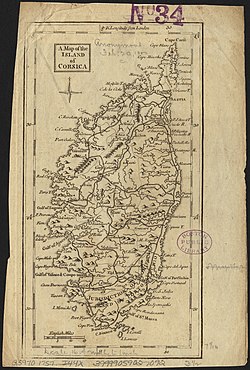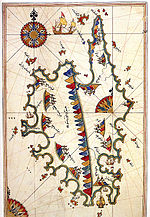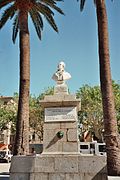Corsican Republic
Corsican Republic | |||||||||
|---|---|---|---|---|---|---|---|---|---|
| 1755–1769 | |||||||||
| Motto:Amici e non di ventura (English:Friends, and not by mere accident) | |||||||||
| Anthem:Dio vi salvi Regina ("God save you Queen") | |||||||||
 Corsica in 1757 | |||||||||
| Status | Unrecognized state | ||||||||
| Capital | Corte | ||||||||
| Official languages | Italian | ||||||||
| Common languages | Corsican | ||||||||
| Government | Modifiedparliamentaryconstitutional republic
| ||||||||
| General | |||||||||
• 1755–1769 | Pasquale Paoli | ||||||||
| Legislature | General Diet | ||||||||
| Historical era | Age of Enlightenment | ||||||||
• Independence declared | July 1755 | ||||||||
| 18 November 1755 | |||||||||
| 15 May 1768 | |||||||||
| 8–9 October 1768 | |||||||||
| 9 May 1769 | |||||||||
| Currency | Soldo | ||||||||
| |||||||||
| Today part of | France ∟Corsica | ||||||||
| History ofCorsica |
|---|
 |
|
|
TheCorsican Republic(Italian:Repubblica Corsa) was a short-lived state on the island ofCorsicain the Mediterranean Sea. It was proclaimed in July 1755 byPasquale Paoli,who was seeking independence from theRepublic of Genoa.Paoli created theCorsican Constitution,which was the firstconstitutionwritten in theItalian language.The text included variousEnlightenmentprinciples, includingfemale suffrage,[1]later revoked by the Kingdom of France when the island was taken over in 1769. The republic created anadministrationandjustice system,and founded an army.
Foundation
[edit]After a series of successful actions, Paoli drove theGenoesefrom the whole island except for a few coastal towns. He then set to work re-organizing the government, introducing many reforms. He founded auniversityatCorteand created a short-lived "Order of Saint-Devote" in 1757 in honour of the patron saint of the island,Saint Devota.[2]
The Republic minted its own coins atMuratoin 1761, imprinted with theMoor's Head,the traditional symbol of Corsica.
Paoli's ideas of independence, democracy and liberty gained support from such philosophers asJean-Jacques Rousseau,Voltaire,Raynal,andMably.[3]The publication in 1768 ofAn Account of CorsicabyJames Boswellmade Paoli famous throughout Europe.Diplomatic recognitionwas extended to Corsica by theBey of Tunis.[4]
Government
[edit]According to the constitution, the legislature, the CorsicanDiet(or Consulta Generale), composed of over 300 members, met once a year on call of the head of state and was composed of delegates elected by acclamation from each parish for three-year terms. The Diet enacted laws, regulated taxation, and determined national policy. Executive powers were handled by the Council of State, elected by the Diet initially for life and which met twice a year, in the absence of which powers were held by the General (chair of the Council) or in their absence, by the President General or by one president from each of the three magistracies of the Council (rotated monthly), one councilor (rotated between the three magistracies every 10 days), and the secretary of state. The General was elected by the Council and had to maintain their confidence in order to remain in the position, although there were no term limits.[5]The General also had a right to summon particular congresses on specific issues separate from the Diet. In the council, two-thirds of its members were to come fromDeçà des Monts,while the remainder were to come fromDelà des Monts.The members were also split into two tiers: 36 first class Presidents, and 108 second class Councillors. The Council was divided into three magistracies: the Chamber of Justice (in charge of political affairs and the most serious criminal cases), the Chamber of War (in charge of military affairs), and the Chamber of Finance (in charge of economic affairs). Petitions made to the Council were addressed to the General, who according to importance, passed them to the applicable magistracy. From there, once studied, it would pass to the full Council for a vote. The head of the Council received two votes while other members received one. In the case of a tie, the secretary of state would vote to break it.
Other than the most serious crimes, other business was delegated to various tribunals. The chief civil court, the Rota Civile (from 1763 also entrusted with criminal cases), was composed of threedoctors of lawnominated for life by the Council. Provincial Magistratures were also established over time, able to judge minor criminal and civil offences. Minor civil cases were handled by the local judge in each of the 68 pieve (traditional administrative divisions). The Sindicato was a body that enabled the Diet to scrutinize the conduct of magistrates and officials except those from the Junta of War, being composed of the President of the Council and four members elected by the Diet. The Junta of War was in times of crisis authorized to condemn to prison and corporal punishment, and to confiscate and/or destroy property. It was able to mobilize local militias to enforce its sentences. It could also impose the death penalty in some cases.[5]
Suffrage was extended to all men over the age of 25,[6][7]and those men over the age of 35 could become members of the Council. Traditionally, women had always voted in village elections forpodestà(i.e. villageelders) and other local officials,[8]and it has been claimed that they also voted in national elections under the Republic if they were head of the family.[9]
Modifications
[edit]In 1758, the Diet reduced the Council from over 100 to 18 members (each of which had to live in Corte), and limited each of their terms to six months. In 1764 the number of Council members was reduced again to 9, each elected for a year.
From 1763, members of the clergy were allowed to send around 137 members to the Diet, and their influence grew such that by the following year the elected speaker of the diet until the dissolution of the republic was always a member of the clergy. Prior to 1763, members of the clergy were not allowed (by legislation) to be judged by canon law, and de facto were not allowed to give asylum to criminals.
In December 1763, the Diet passed legislation modifying the method of election of its members, where a reduced 68 members were to be indirectly elected. In this legislation, the number of clerical members were unchanged, as was the recently introduced practice of allowing the head of state to invite others to participate in the Diet. However, this legislation was never respected, de facto continuing under the old system. The following year elected members of the diet were made to be equipped with an notarial affidavit, stating they also had a right to, with other members of the pieve, elect one or more of themselves to represent the pieve as a whole, allowing the election of more than one person to represent a pieve.
In 1764, the Council of State was granted a suspensive veto, allowing them to suspend a resolution voted on by the Diet until it gave its motives for refusal, after which the Diet had an opportunity to reconsider and pass it again with no opportunity for a veto. In the sane session, resolutions were changed such that they required a two-thirds majority to be passed, although those that gained at least 50% support were allowed to be brought up again in the same session (while those that did not were not allowed, and could only be re-introduced in a future session with the consent of the Council).
In 1766, another attempt was made to change the method of election in each parish for its Diet representative(s), where he "was to be elected from a choice of three candidates proposed by the Podestats and 'Fathers of the Commune'; he had to win a two-thirds majority. Only heads of families had the right to vote. If none of the three won the required majority, another election was to take place. In this case, candidates were to be proposed by the heads of families. Three were to be selected by majority vote in a primary election; one of the three was to be elected in a secondary election by a two-thirds majority. If none of them won this majority, the parish forfeited its representation in that session of the Diet." This attempted change, similar to the prior one attempted in 1763, was seldom followed.[5]
French invasion
[edit]In 1767, Corsica took the island ofCapraiafrom the Genoese who, one year later, despairing of ever being able to control Corsica again, sold their claim to theKingdom of Francewith theTreaty of Versailles.France invaded Corsica the same year, with Paoli's forces fighting to keep the republic intact. However, in May 1769, at theBattle of Ponte Novuthey were defeated by vastly superior forces commanded by theComte de Vaux,and obliged to take refuge in theKingdom of Great Britain.
French control was consolidated over the island, and in 1770 it became aprovinceof France. Under France, the use ofCorsican(a regional language closely related toItalian) has gradually declined in favour of the standardFrench language.Italian was the official language ofCorsicauntil 1859.[10]
Aftermath
[edit]
Thefall of Corsica to the Frenchwas poorly received by many inGreat Britain,which was Corsica's main ally and sponsor. It was seen as a failure of theGrafton Ministrythat Corsica had been "lost", as it was regarded as vital to the interests of Britain in that part of the Mediterranean.[11]TheCorsican Crisisseverely weakened the Grafton Ministry, contributing to its ultimate downfall. A number of exiled Corsicans fought on the British side during theAmerican Revolutionary War,serving with particular distinction during theGreat Siege of Gibraltarin 1782.
Conversely, at the beginning of the same war, the New York militia later namedHearts of Oak- whose membership includedAlexander Hamiltonand other students at New York's King's College (now Columbia University) - originally called themselves "The Corsicans",evidently considering the Corsican Republic as a model to be emulated in America.[citation needed]
The aspiration for Corsican independence, along with many of the democratic principles of the Corsican Republic, were revived by Paoli in theAnglo-Corsican Kingdomof 1794–1796. On that occasion, British naval and land forces were deployed in defence of the island; however, their efforts failed and the French regained control.
To this day, someCorsican separatists,such as the (now-disbanded)Armata Corsa,advocate the restoration of the island's republic.
See also
[edit]References
[edit]- ^Lucien Felli, "La renaissance du Paolisme". M. Bartoli,Pasquale Paoli, père de la patrie corse,Albatros, 1974, p. 29. "Il est un point où le caractère précurseur des institutions paolines est particulièrement accusé, c'est celui du suffrage en ce qu'il était entendu de manière très large. Il prévoyait en effet le vote des femmes qui, à l'époque, ne votaient pas en France."
- ^"The Church of St Devote of Monaco".www.gouv.mc.Archived fromthe originalon 2009-02-21.
- ^Scales, Len; Oliver Zimmer (2005).Power and the Nation in European History.Cambridge: Cambridge University Press. p. 289.ISBN0-521-84580-7.
- ^Thrasher, Peter Adam (1970).Pasquale Paoli: An Enlightened Hero 1725-1807.Hamden, CT: Archon Books. p. 117.ISBN0-208-01031-9.
- ^abcCarrington, Dorothy (1973)."The Corsican Constitution of Pasquale Paoli (1755-1769)".The English Historical Review.88(348): 481–503.doi:10.1093/ehr/LXXXVIII.CCCXLVIII.481.ISSN0013-8266.JSTOR564654.
- ^Gregory, Desmond (1985).The ungovernable rock: a history of the Anglo-Corsican Kingdom and its role in Britain's Mediterranean strategy during the Revolutionary War, 1793-1797.London: Fairleigh Dickinson University Press. p. 31.ISBN0-8386-3225-4.
- ^Gama Sosa, Michele (2021-06-21)."THE HEROIC STORY OF THE ISLAND THAT INSPIRED THE AMERICAN REVOLUTION".Grunge.Retrieved2023-08-14.
- ^Gregory, Desmond (1985).The ungovernable rock: a history of the Anglo-Corsican Kingdom and its role in Britain's Mediterranean strategy during the Revolutionary War, 1793-1797.London: Fairleigh Dickinson University Press. p. 19.ISBN0-8386-3225-4.
- ^Felli, Lucien (1974). "La renaissance du Paolisme". In Bartoli, M (ed.).Pasquale Paoli, père de la patrie corse.Paris: Albatros. p. 29.
Il est un point où le caractère précurseur des institutions paolines est particulièrement accusé, c'est celui du suffrage en ce qu'il était entendu de manière très large. Il prévoyait en effet le vote des femmes qui, à l'époque, ne votaient pas en France.
- ^Abalain, Hervé, (2007)Le français et les langues historiques de la France,Éditions Jean-Paul Gisserot, p.113
- ^Simms, Brendan (2008).Three Victories and a Defeat: The Rise and Fall of the First British Empire, 1714-1783.London: Penguin Books. p. 663.ISBN978-0-14-028984-8.
External links
[edit]


